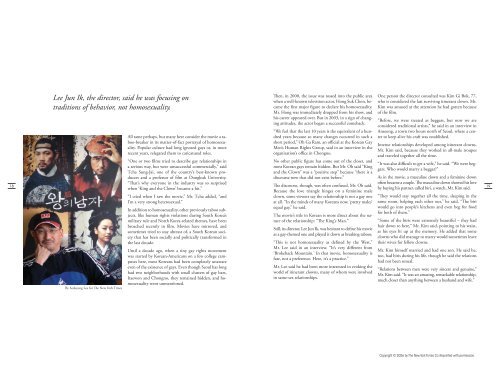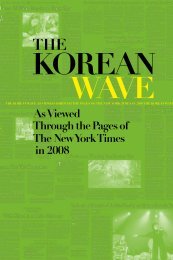The Korean Wave 2006 - Korean Cultural Service
The Korean Wave 2006 - Korean Cultural Service
The Korean Wave 2006 - Korean Cultural Service
Create successful ePaper yourself
Turn your PDF publications into a flip-book with our unique Google optimized e-Paper software.
18<br />
Lee Jun Ik, the director, said he was focusing on<br />
traditions of behavior, not homosexuality.<br />
By Seokyong Lee for <strong>The</strong> New York Times<br />
All tame perhaps, but many here consider the movie a taboo-breaker<br />
in its matter-of-fact portrayal of homosexuality.<br />
Popular culture had long ignored gays or, in more<br />
recent years, relegated them to caricatured roles.<br />
“One or two films tried to describe gay relationships in<br />
a serious way, but were unsuccessful commercially,” said<br />
Tcha Sung-Jai, one of the country’s best-known producers<br />
and a professor of film at Dongkuk University.<br />
“That’s why everyone in the industry was so surprised<br />
when ‘King and the Clown’ became a hit.”<br />
“I cried when I saw the movie,” Mr. Tcha added, “and<br />
I’m a very strong heterosexual.”<br />
In addition to homosexuality, other previously taboo subjects,<br />
like human rights violations during South Korea’s<br />
military rule and North Korea-related themes, have been<br />
broached recently in film. Movies have mirrored, and<br />
sometimes tried to stay abreast of, a South <strong>Korean</strong> society<br />
that has been socially and politically transformed in<br />
the last decade.<br />
Until a decade ago, when a tiny gay rights movement<br />
was started by <strong>Korean</strong>-Americans on a few college campuses<br />
here, most <strong>Korean</strong>s had been completely unaware<br />
even of the existence of gays. Even though Seoul has long<br />
had two neighborhoods with small clusters of gay bars,<br />
Itaewon and Chongno, they remained hidden, and homosexuality<br />
went unmentioned.<br />
<strong>The</strong>n, in 2000, the issue was tossed into the public area<br />
when a well-known television actor, Hong Suk Chon, became<br />
the first major figure to declare his homosexuality.<br />
Mr. Hong was immediately dropped from his show, and<br />
his career appeared over. But in 2003, in a sign of changing<br />
attitudes, the actor began a successful comeback.<br />
“We feel that the last 10 years is the equivalent of a hundred<br />
years because so many changes occurred in such a<br />
short period,” Oh Ga Ram, an official at the <strong>Korean</strong> Gay<br />
Men’s Human Rights Group, said in an interview in the<br />
organization’s office in Chongno.<br />
No other public figure has come out of the closet, and<br />
most <strong>Korean</strong> gays remain hidden. But Mr. Oh said “King<br />
and the Clown” was a “positive step” because “there is a<br />
discourse now that did not exist before.”<br />
<strong>The</strong> discourse, though, was often confused, Mr. Oh said.<br />
Because the love triangle hinges on a feminine male<br />
clown, some viewers say the relationship is not a gay one<br />
at all. “In the minds of many <strong>Korean</strong>s now, ‘pretty males’<br />
equal gay,” he said.<br />
<strong>The</strong> movie’s title in <strong>Korean</strong> is more direct about the nature<br />
of the relationship: “<strong>The</strong> King’s Man.”<br />
Still, its director, Lee Jun Ik, was hesitant to define his movie<br />
as a gay-themed one and played it down as breaking taboos.<br />
“This is not homosexuality as defined by the West,”<br />
Mr. Lee said in an interview. “It’s very different from<br />
‘Brokeback Mountain.’ In that movie, homosexuality is<br />
fate, not a preference. Here, it’s a practice.”<br />
Mr. Lee said he had been more interested in evoking the<br />
world of itinerant clowns, many of whom were involved<br />
in same-sex relationships.<br />
One person the director consulted was Kim Gi Bok, 77,<br />
who is considered the last surviving itinerant clown. Mr.<br />
Kim was amused at the attention he had gotten because<br />
of the film.<br />
“Before, we were treated as beggars, but now we are<br />
considered traditional artists,” he said in an interview in<br />
Anseong, a town two hours north of Seoul, where a center<br />
to keep alive his craft was established.<br />
Intense relationships developed among itinerant clowns,<br />
Mr. Kim said, because they worked in all-male troupes<br />
and traveled together all the time.<br />
“It was also difficult to get a wife,” he said. “We were beggars.<br />
Who would marry a beggar?”<br />
As in the movie, a masculine clown and a feminine clown<br />
often became a couple. <strong>The</strong> masculine clown showed his love<br />
by buying his partner, called biri, a watch, Mr. Kim said.<br />
“<strong>The</strong>y would stay together all the time, sleeping in the<br />
same room, helping each other out,” he said. “<strong>The</strong> biri<br />
would go into people’s kitchens and even beg for food<br />
for both of them.”<br />
“Some of the biris were extremely beautiful – they had<br />
hair down to here,” Mr. Kim said, pointing to his waist,<br />
as his eyes lit up at the memory. He added that some<br />
clowns who did manage to marry would sometimes leave<br />
their wives for fellow clowns.<br />
Mr. Kim himself married and had one son. He said he,<br />
too, had biris during his life, though he said the relations<br />
had not been sexual.<br />
“Relations between men were very sincere and genuine,”<br />
Mr. Kim said. “It was an amazing, remarkable relationship,<br />
much closer than anything between a husband and wife.”<br />
19<br />
Copyright © <strong>2006</strong> by <strong>The</strong> New York Times Co. Reprinted with permission.





